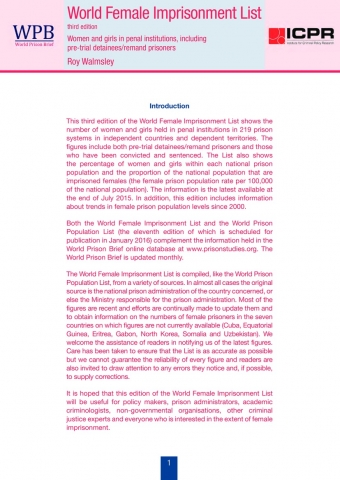
Over 700,000 women and girls in prison around the world, new report by Institute for Criminal Policy Research shows
More than 700,000 women and girls are held in penal institutions throughout the world, according to the third edition of the World Female Imprisonment List, researched and compiled by Roy Walmsley and published by the Institute for Criminal Policy Research at Birkbeck, University of London.
The List is available here
The analysis indicates that female prison population levels have grown much faster than male prison population levels since around the year 2000, with the number of women and girls in prison increasing by 50% in the past 15 years.
The study provides information for almost all countries in the world about the female prison population, the percentage of the total prison population they comprise and the rate per 100,000 of the national population. It also includes information about trends in female imprisonment.
It shows that more than 200,000 imprisoned women and girls are in the USA (205,400) and more than 100,000 are in China (103,766 plus an unknown number in pre-trial or administrative detention). The next highest totals are in the Russian Federation (53,304), Thailand (44,751), Brazil (37,380), Vietnam (20,553), India (18,188) and Mexico (13,400).
Female prisoners generally constitute between 2 and 9% of the total prison population; apart from three countries with very small national populations*, the highest levels are in Hong Kong-China (over 19%), Macau-China (almost 18%), Myanmar (over 16%), Bolivia, Qatar, Thailand and Vietnam (between 14 and 15%) and Kuwait (almost 14%).
The proportion of women and girls within the total prison population is lowest in African countries, where the median level is 2.8%, and highest in Asian countries, where the median is 6.0%. The median level in Europe is 4.9% and the overall world median is 4.4%.
There are also considerable variations in the proportion of the national population that female prisoners constitute. The lowest levels are again in Africa where the median is 2.5 per 100,000 of the national population. In Asia the median level is three times as high and in the Americas more than four times as high. The highest female prison population rates are in Thailand (66.4 per 100,000 of the national population), U.S.A. (64.6), Seychelles (48.9), El Salvador (45.9), Turkmenistan (38.2) and the Russian Federation (36.9).
The number of women and girls in prison has increased by 50% since about the year 2000. This cannot be explained in terms of the growth in national population levels: United Nations figures for the world population indicate that this rose only by 18% in about the same period.
The female prison population has risen in all continents. The increases have been greater than the growth in national population levels, except in Africa where the rise in the female prison population was only half as great as the increase in the population of the continent. Rises in the female prison population in the Americas, in Oceania and in Asia have been respectively three, four and five times the increases in the populations of those continents.
Current indications are that female prison population levels have not only grown sharply; they have grown much faster than male prison population levels. It is provisionally estimated that the total world prison population has increased by around 20% since 2000, compared to the approximately 50% increase in the overall number of imprisoned women and girls. More information will be available in the forthcoming eleventh edition of the World Prison Population List.
Compiler of the World Female Imprisonment List, Roy Walmsley, comments:
The astonishingly sharp rise in recent years in the number of women and girls in prison, and the substantial variations in female imprisonment levels between neighbouring countries, between different regions and between different continents, should prompt policy makers in all countries to consider what they can do to limit the number of women in custody. Female imprisonment has a high financial and social cost and its excessive use does nothing to improve public safety.
Co-Director of the Institute for Criminal Policy Research at Birkbeck, University of London, Dr Jessica Jacobson, comments:
With the publication of this latest edition of the World Female Imprisonment List, the Institute for Criminal Policy Research draws attention to the high and rapidly increasing numbers of women and girls held in penal institutions worldwide. These women and girls make up a small but growing minority of the total world prison population; they are an extremely vulnerable and disadvantaged group, and tend to be victims of crime and abuse themselves. The approximately 50% increase in numbers of imprisoned women and girls over the past 15 years should be of profound concern to governments, prison administrations and all who are committed to justice and penal reform.
* Liechtenstein (22.2%), Monaco (17.4%) and Greenland (13.8%)